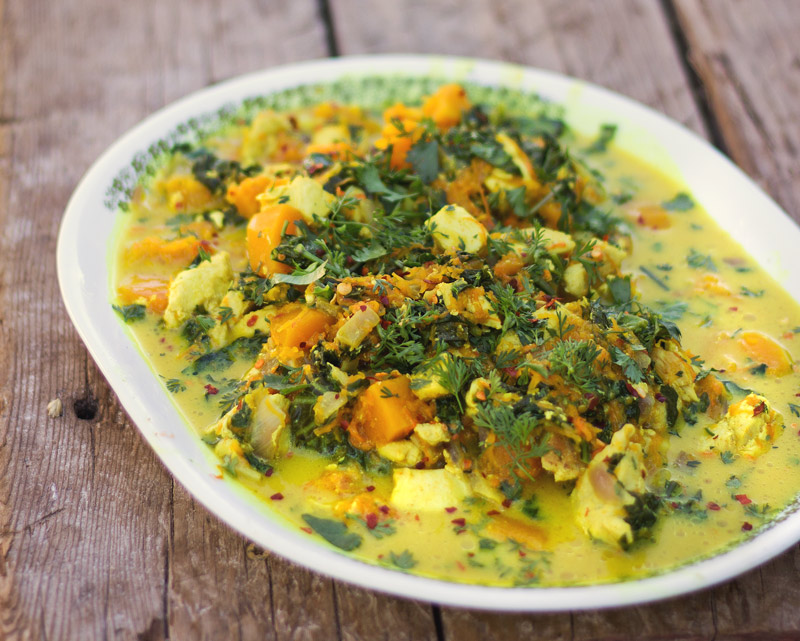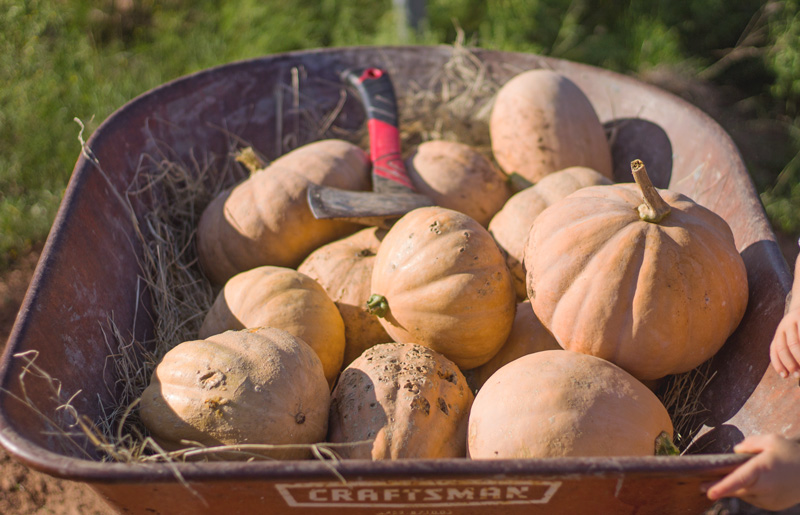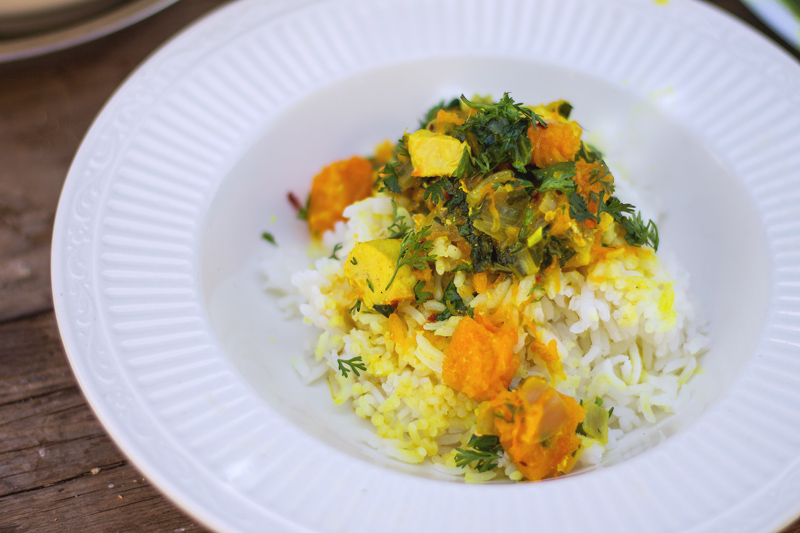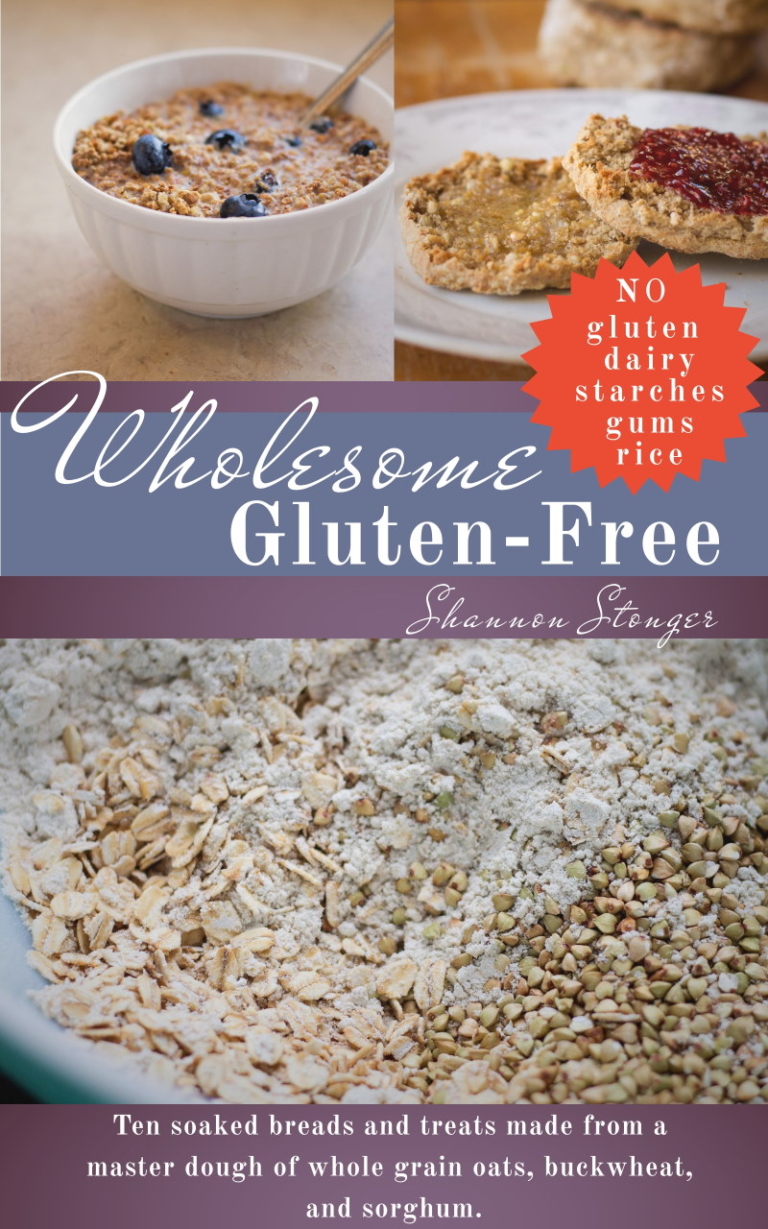Chicken and Pumpkin Curry with Kale
 Seasons cross over and food stores are put to the test during these spring days. Seeds and seedlings have been going into the ground regularly since February and some of the cooler weather crops have been making their way to the table for some time now. Salads with radish and lettuce are a regular item as is the abundant kale patch planted last fall. And beets – I picked real live beets yesterday, y’all!
Seasons cross over and food stores are put to the test during these spring days. Seeds and seedlings have been going into the ground regularly since February and some of the cooler weather crops have been making their way to the table for some time now. Salads with radish and lettuce are a regular item as is the abundant kale patch planted last fall. And beets – I picked real live beets yesterday, y’all!
But when you work at growing food, you know it is not all full-harvest-baskets and perfect-germination. This spring has been quite different from last year for many reasons, one of which is the later frosts our garden received. Lord willing, I will share more on that soon but please know that while we are still eating up last year’s harvests and are quite thankful for those and the provisions from this spring, if you’ve had poor germination or lost a crop, you are not alone.

With that said, I sent Abram down to the cellar last week for the last two pumpkins from last year’s harvest. I canned a bunch so we will still have plenty for pies and other treats, but I was making a main dish for a crowd so I wanted to use whatever we could from our stores. So the pumpkins combined with some garden kale and cilantro, as well as some store-bought ingredients, to make our supper one night and a meal for a crowd the next day.
As is the case with most curries and stews, it is always better the next day.
Chicken and Pumpkin Curry with Kale
Serves 20. Feel free to halve or quarter this recipe as needed, keeping in mind how good leftovers generally are.
Ingredients
- 1/3 cup coconut oil or lard
- 2 large onions, sliced thinly
- 3 pounds boneless, skinless chicken pieces, cut into bite-size pieces
- 2 small pumpkins, halved, peeled, seeded, and chopped into 1″ cubes
- 1 head garlic, peeled and minced
- 1 quart broth or water
- 2 cans coconut milk
- 4 Tablespoons ground turmeric
- 2 teaspoons ground cumin
- 1 teaspoon ground ginger
- 1/2 teaspoon each ground coriander and cardamom
- 1 -2 teaspoons red pepper flakes, to taste
- 3 Tablespoons apple cider vinegar
- 2-3 large bunches kale
- 2 cups chopped cilantro
- Cooked rice, to serve

Directions
Add the coconut oil or lard to a Dutch oven over medium-high heat. Add the sliced onions and fry, stirring frequently, until the onions have softened. Remove these to a platter and begin frying the chicken, in batches, adding fat if needed between batches. Fry the chicken pieces hot and fast on both sides until just browned and then remove to platter with onions. Be sure you don’t overcrowd the pan as you fry the meat so that it browns nicely.
Once all of the meat is browned and removed to a platter, add the pumpkin to the pot with the garlic and broth. The broth should just come below the level of the pumpkin, so add additional broth or water as needed. Bring the broth and pumpkin to a simmer and turn the heat down. Cover and allow to simmer until the pumpkin is cooked halfway to tender, about 10 minutes.
Add the coconut milk, chicken and onions back to the pot with the pumpkin. Add all of the spices, vinegar, and chopped kale and simmer for an additional 5-10 minutes or until the pumpkin is tender and the chicken cooked through.
Season with salt to taste and adjust heat, adding more red pepper flakes if desired. Serve over rice with a generous sprinkling of cilantro.


I love homemade curries. Haven’t made one in ages, though. I’m going to have to get some pumpkin and add this to my menu!
This sounds INCREDIBLE! All that creamy/spicy sauce is making my mouth water! I’m a sucker for curries!
Pumpkin curry?! I so want to try this!
Hi Shannon! The curry looks delicious, but I’m commenting on your late frosts and wanted to share something from another person who uses homeopathic remedies for her garden and orchard. It’s quoted below. I haven’t tried these myself yet, but plan to when needed. If you have questions about it, feel free to ask! Using homeopathic remedies for plants is a pretty new “field” of research, so there’s not much information out there.
“I live in North Ms, and our last frost date is April 4-6. Sure enough, Sunday morning, April 8th, we had a hard frost. 28° with frost on the ground and ice on the water collection barrels.
My apple trees are in bloom right now. I treated them with the Frost Tonic, per Maute’s book: about 10 pellets of each: Aconite 200c, Belladonna 200c, and Calendula 30c, dissolved in 16oz of water. Since we have had a lot of rain, I just sprinkled 3 to 4 T around each tree. Normally, a third of the bottle would be poured in a 2 1/2 gallons of water and a little poured around the tree.
Monday afternoon: It’s 62° right now and my apple trees are full of healthy blooms with bees buzzing around.
My peach trees went through 5 hard frosts, in the last month, I treated them after each frost if they were blooming. I looked at them yesterday while treating them and they have fruit on them!
I’m excited about the bees, also, because they have been scarce the last few years. I treated each tree with the bee tonic; per Maute’s book. Pulsatilla 30c and Nux Vomica 30c, I mixed and treated them the same as with the Frost Tonic.
I’m excited to see the positive results from the Homeopathic treatments.”
Hi Katie,
Thanks so much for sharing all of that! I’ve not heard of any of that before so it is all new to me. The weather is so unpredictable here that we are getting more used to just rolling with the punches and I am thankful that so much has survived, despite the frosts and other extremes.
By the way, our top favorite winter squash here is sweet meat. I grew up with it and found the seed at Heritage Harvest (they only ship in Canada). It’s the sweetest winter squash of everything we’ve tried so far and works so well for any pumpkin/squash recipe, sweet or savory. There are probably seed companies in the U.S. that carry it, too.
Katie – Ya know I have heard a lot of great things about that variety. We did try it one year but it never took off and I am wondering if it is too warm and dry here? Maybe we should try it again, huh? I think Southern Exposure carries that seed, if I remember correctly. Thanks for the reminder!
I’d say it’s worth another try! Maybe grown alongside something else that you know works well in your climate? I grew up in a Zone 7-8 and now live in a Zone 3, so I’m learning that some things just don’t work here that work in warmer zones! We’re experimenting with new varieties and methods every year.
I will never forget my friend from India. He invited my husband and me over his house to celebrate his wife arriving to the US. They made a vegetarian covered curry for my husband and me and Mirosh said to me, don’t worry Jeannie, we made is mild for you. No way was that mild. But, I learned to enjoy the burn of the India food because after the initial shock, the things that happen to the taste buds is phenomenal.
I left beets, carrots, turnips, parsley, and a bunch of herbs (chives, rosemary, mint, cilantro) in my garden all winter. I did cover them with straw and leaves but didn’t think they would survive the weeks of 7 degree weather but they did and I picked a panful of beets before this last rain and we had roasted beets and potatoes for dinner. I am doing a winter plant this fall because there are so many vegetables that will thrive or at least live and start growing when the temperature goes above 30.
I don’t know if I ever told you about the bees on our property. I only mention now because of the above commenter. We bought out land very cheap and it has a very small falling down house on it that we are slowly rebuilding…but it also had four dead locust trees on it and a couple of plum trees that were ill. I am allergic to bees and wasps. While I was working on the plum tree (cleaning the wound on the side, putting a insect killer on it, and tying the broken trunk back together), I saw the birds going crazy atop two of the dead trees and I went to inspect and there were bees swarming like crazy. Then I noticed something sticky all over the top of the trunk of both dead trees. I called a local bee keeper who came and said we had two of the healthiest wild bee hives he has ever seen and he said he has been saving wild bees for fifty years. Anyway, he set the hives up in our back yard and moved the bees from the trees to the boxes and over the next several months he tended to the hives, gave us tons of the wild honey from the trees and then from hives he brought. I will never run out of honey and I got all the wax and have made a ton of wonderful skin products, candles, and furnish polish. Anyway, he eventually moved the hives to a farm that grows milo, the stuff they make sorghum from, and recently, he helped me start a new beehive with domestic bees. He is still helping me take care of them. Yesterday, it was raining and we had tornado warnings out and John (beehive guy) came over to make sure the hive was secure and he said, you know that plum tree and I said, oh no, please don’t tell me its dead and he said, well, there’s a dead branch at the top that has big hole in it and you have some wild bees…I’m going to get them out when the rain starts because they will take over your beehive. I am loving having the bees but am still very allergic. I just carry my epipens when I am in the back of the property.